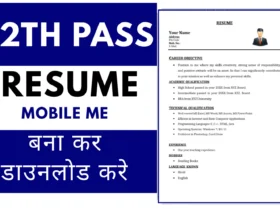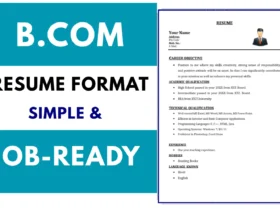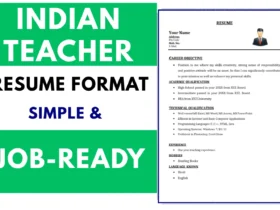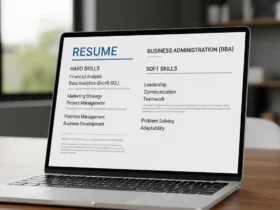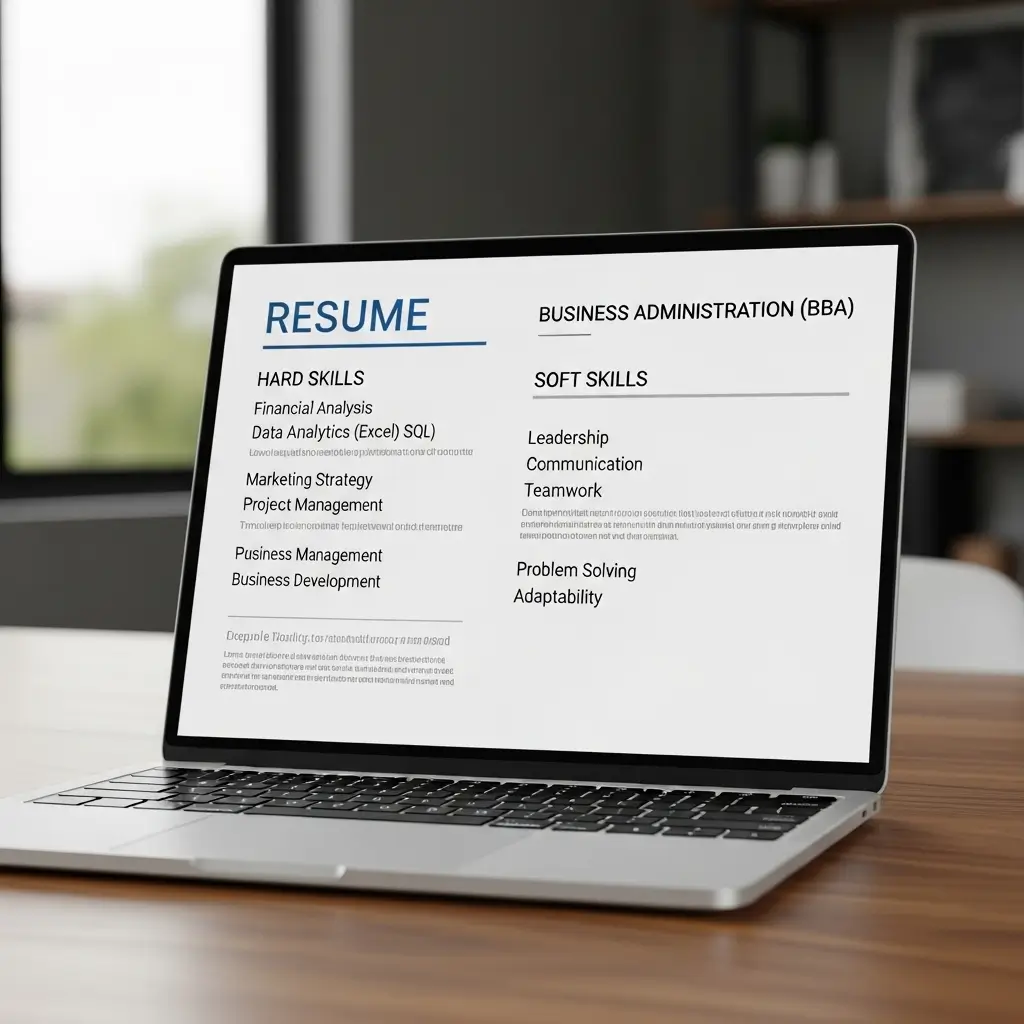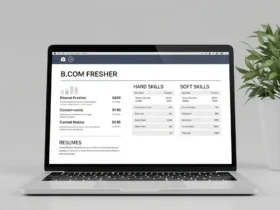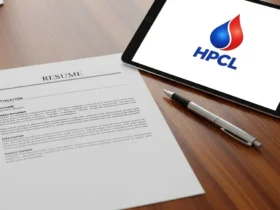So, you’ve got that BBA. That’s awesome! Business administration, right? It’s a huge field, super versatile. But, let’s be real for a second, sometimes “versatile” can feel a little bit… overwhelming when you’re staring at a blank document, trying to build your resume. You know, like, where do you even start? What exactly should pop off the page for someone hiring in finance, marketing, or HR? It’s not like a nursing resume or an engineering one where the path feels a bit more defined.
That’s the thing, isn’t it? Your BBA gives you a fantastic foundation. You’ve probably touched on a bunch of different business areas, maybe even done a bit of everything. But when it comes to getting that first (or next) job, your resume is your very first handshake. It’s what speaks for you before you even open your mouth. And a generic resume? That’s like showing up to a fancy dinner in sweatpants. It just doesn’t make the right impression. What we need is a BBA resume format that actually works. One that shows off what you can do, not just what you’ve studied.
Think about it. Recruiters, hiring managers – they’re busy people. They’re sifting through piles, sometimes hundreds, of applications. They’re not looking to read your life story. They’re scanning, looking for keywords, for numbers, for things that scream “this person can do the job!” So, how do you make your BBA resume stand out in that sea of applicants? How do you make sure your unique blend of business knowledge really shines through? It’s all about the format, the layout, and what you choose to highlight.
We’re going to break it down, step by simple step. No fancy jargon, no complicated rules, just practical advice for getting your BBA resume in top shape. We’ll talk about making it look clean, easy to read, and packed with the right stuff. Because, let’s be honest, you’ve worked hard for that degree. It’s time to make it work hard for you on paper. Ready to get started? Let’s peel back the layers and figure out what a truly effective BBA resume looks like.
BBA Resume Format For Freshers & Experienced
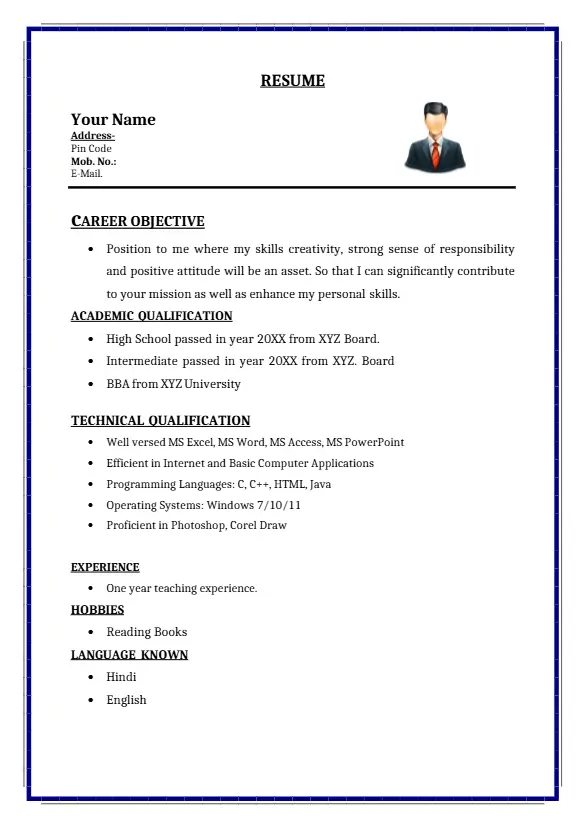
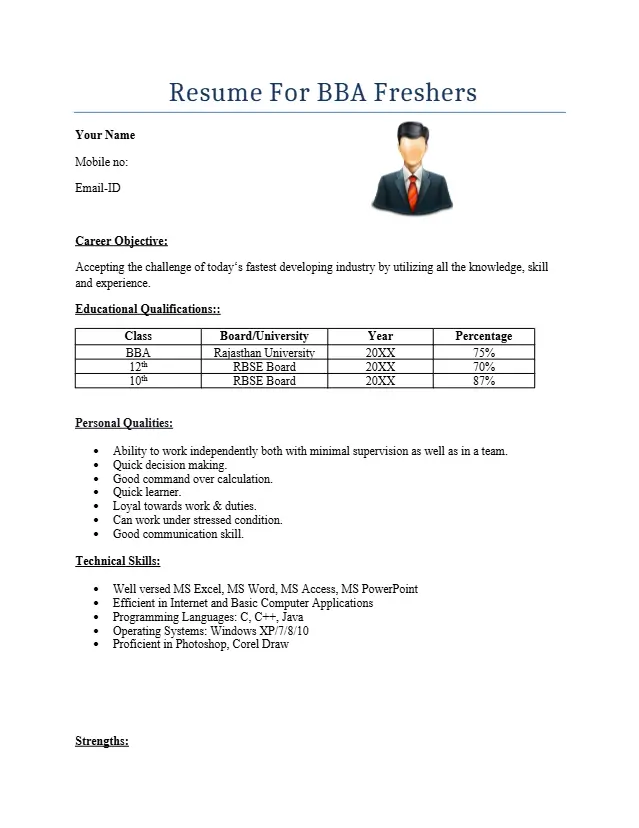
👉 Download Link: [Get Here]
You can:
- Fill it in Adobe or any PDF app
- Print it on clean A4 paper
How to Write BBA Resume For Freshers & Experienced
The Basic Layout — Keep It Simple
First things first: simplicity is king. Seriously. When it comes to your BBA resume, you don’t want anything too busy or overly designed. Think clean lines, clear sections. A recruiter should be able to glance at it and immediately understand who you are, what you’ve done, and what you’re looking for. No riddles, no puzzles.
So, what does this “simple” layout actually look like? Generally, you’re looking at a single-column or a two-column design. A single column is usually safer and often preferred, especially if you’re just starting out or have less experience. It’s linear, easy to follow. A two-column layout can work if you’re trying to fit more information onto one page and keep it looking organized, but be careful not to make it feel cramped. My advice? Stick with one page if you can, especially as a recent grad. If you have significant experience (say, 5+ years), then maybe two pages are okay. But for BBA grads, one page is the sweet spot. It forces you to be concise, and that’s a good thing.
Now, let’s talk about the sections you absolutely need. Every BBA resume, no matter what, should have these core parts:
- Contact Information: Obvious, right? But crucial.
- Summary or Objective: A quick intro to you.
- Education: Your BBA, of course!
- Experience: Internships, part-time jobs, even volunteer work.
- Skills: What you’re good at, specifically.
Those are your non-negotiables. We’ll dive into each one, talking about what to put in, what to leave out, and how to make it sound good without sounding like a robot.
Contact Info and That Opening Statement
Okay, the very top of your resume. This is your personal billboard. It’s where you put your name, phone number, email, and maybe your LinkedIn profile. Make it super easy for them to get in touch.
- Your Name: Make it prominent. Bigger font, bold. It’s your resume.
- Phone Number: A professional one, please. No crazy voicemails.
- Email Address: Again, keep it professional. “yourname@email.com” is perfect. Avoid “partyanimal2025@email.com.” Seriously.
- LinkedIn Profile: If it’s updated and professional, include it. It’s basically an online resume, a chance for them to learn more. Make sure it matches your resume! Consistency is key.
- Location (Optional but good): City, State is usually enough. No need for your full address. This helps if they’re looking for local candidates.
Right below that? Your opening statement. This is either a “Resume Objective” or a “Professional Summary.” What’s the difference, and which one should you use?
- Resume Objective: This is for recent grads or those with limited experience. It states your career goals and what you hope to achieve in the role. It’s about what you want.
- Example: “Highly motivated BBA graduate seeking an entry-level marketing analyst position to leverage analytical skills and contribute to strategic campaign development.”
- Professional Summary: This is for those with some experience. It highlights your key skills and achievements and what you can offer the employer. It’s about what they want.
- Example: “Results-oriented BBA professional with 2 years of experience in project coordination and data analysis, adept at optimizing operational workflows and improving team productivity.”
For most BBA grads, an objective is fine. But even if you’re fresh out of school, if you’ve had internships or relevant projects, try to lean towards a summary if you can. It’s more impactful because it focuses on what you bring to the table. Whichever you choose, keep it to 2-4 sentences. Make it punchy. It’s like your elevator pitch for the resume itself. It needs to grab attention fast. What’s your biggest selling point right now? Put that front and center.
Education, Of Course:
Alright, now for the star of the show for many BBA grads: your education. This section is super important. You’ve worked hard for this degree, so let’s make sure it’s presented clearly and effectively.
Here’s what to include, typically in reverse chronological order (most recent first):
- Degree Name: Bachelor of Business Administration (BBA). Be explicit.
- Major/Concentration: If you specialized in something like Marketing, Finance, Human Resources, or Supply Chain Management, definitely list that. It tells them more about your specific expertise.
- University Name: Spell it out. No abbreviations unless it’s universally recognized.
- City, State: Where the university is located.
- Graduation Date (or expected date): Month and year is good. If you haven’t graduated yet, put “Expected [Month, Year]”.
- GPA (Optional, but good if high): If your GPA is 3.5 or above (on a 4.0 scale), include it. If it’s lower, you can probably leave it off. No need to highlight something that doesn’t strengthen your application.
- Honors/Awards: Dean’s List, Magna Cum Laude, scholarships, specific academic awards. These show dedication and excellence.
- Relevant Coursework (Optional): This is where you can be smart, especially if you lack direct work experience. List 3-5 courses that are directly relevant to the job you’re applying for. This helps bridge the gap and shows you have foundational knowledge. For example, if applying for a marketing role, list “Digital Marketing,” “Consumer Behavior,” “Marketing Research.” Don’t list “Intro to Business” unless it’s truly your only relevant course.
Think about the job description for a moment. What skills are they asking for? What knowledge? Your coursework can sometimes demonstrate you’ve got that background, even if you haven’t applied it in a paid job yet. It’s all about making connections. For instance, if you did a big group project that simulated a business challenge, that’s worth a bullet point too. It shows teamwork, problem-solving, and practical application.
- Example:
- Bachelor of Business Administration | [Your University Name], [City, State]
- Major: Marketing | Expected Graduation: May 2026
- GPA: 3.7/4.0 | Honors: Dean’s List (4 Semesters)
- Relevant Coursework: Digital Marketing Strategies, Marketing Analytics, Consumer Behavior, Project Management
See? Clean, clear, and highlights the good stuff. Next up, where the real action happens: your experience.
Experience Section
This is arguably the most critical part of your BBA resume. It’s where you prove you can do things, not just know things. And listen, I get it. If you’re a recent BBA grad, you might think, “But I don’t have ‘real’ experience!” That’s a common misconception. “Experience” isn’t just about full-time, paid jobs. It includes internships, part-time roles, volunteer work, relevant club leadership, even significant academic projects.
The key here is how you frame it. Every bullet point under each experience entry needs to be an achievement, not just a duty. Don’t just list what you did; explain what you achieved and what impact it had. This is where numbers, percentages, and metrics become your best friends. They quantify your impact and make your contributions tangible.
For each entry, list:
- Job Title: Or your role (e.g., Marketing Intern, Project Lead, Volunteer Coordinator).
- Company/Organization Name:
- City, State: Where you worked.
- Dates of Employment/Involvement: Month, Year – Month, Year.
Then, under each, use 3-5 strong bullet points. Start each bullet point with an action verb. Think “managed,” “developed,” “analyzed,” “implemented,” “created,” “increased,” “reduced.”
Now for the magic formula: Action Verb + Task + Result (with numbers!)
- Bad Example: “Responsible for social media posts.” (So bland, tells me nothing.)
- Better Example: “Managed daily social media content schedule across three platforms, engaging with followers.” (A bit better, but still no impact.)
- Great Example (BBA-ready): “Developed and implemented a new social media content strategy for Instagram, increasing engagement by 15% and follower growth by 10% over three months.” (Boom! Numbers, action, impact.)
See the difference? The third one tells a story. It shows you’re proactive, results-oriented, and can make a measurable difference. Even for volunteer work, you can find ways to quantify. Did you organize an event that raised X amount of money? Did you manage Y number of volunteers? Did you streamline a process that saved Z hours? Think hard.
Also, tailor this section. Seriously, tailor it. If you’re applying for a finance role, highlight your experience with budgets, data analysis, or financial reporting. If it’s a marketing role, focus on campaigns, content creation, or market research. Don’t just send the same resume everywhere. It feels generic, and recruiters can tell. Take the time to tweak those bullet points to match what the job description is asking for. It shows you’re paying attention and you’re truly interested.
Your Skills Section
Alright, last but certainly not least, let’s talk about your skills. This section is a goldmine for keywords and can really help your BBA resume get noticed, especially by applicant tracking systems (ATS) that many companies use to filter resumes. Don’t just list a bunch of random skills; be strategic.
Break your skills down into a few categories:
- Technical Skills: These are your hard skills, the tools and software you know.
- Examples: Microsoft Excel (advanced functions like VLOOKUP, PivotTables), PowerPoint, Salesforce, SQL, Google Analytics, Adobe Creative Suite (Photoshop, InDesign), CRM software, specific accounting software (QuickBooks), project management tools (Asana, Trello), data visualization tools (Tableau, Power BI).
- Tip: Be specific about your proficiency level if you can. “Proficient in Excel” is good; “Advanced Excel (PivotTables, VLOOKUP)” is even better.
- Soft Skills (or “Professional Skills”): These are your interpersonal and personal attributes. While generally not as critical for ATS scanning as technical skills, they are huge for recruiters and hiring managers. They show how you work with others and approach challenges.
- Examples: Communication (written and verbal), Teamwork, Problem-Solving, Leadership, Adaptability, Time Management, Critical Thinking, Client Relations, Presentation Skills, Negotiation.
- Caution: Don’t just list a dozen soft skills. Choose 3-5 that are most relevant to the job and that you can back up with examples in your experience section. If you say “Leadership,” make sure you have an example of leading a project or team.
- Languages: If you’re bilingual or multilingual, absolutely include this! Specify your fluency level (e.g., “Fluent in Spanish,” “Conversational in French”). In today’s global economy, this is a massive asset.
How to make this section shine for a BBA:
- Look at the Job Description: Seriously, I can’t stress this enough. If the job description mentions “data analysis,” make sure “Data Analysis” or “Advanced Excel” is in your skills section. If it talks about “client presentations,” list “Presentation Skills.” This is how you beat the ATS and show you’re a perfect fit.
- Prioritize: Put your most relevant and impressive skills at the top of each category.
- Don’t Lie: Only list skills you genuinely possess. You might be asked to demonstrate them! Imagine saying you’re an Excel guru and then freezing when asked to do a simple VLOOKUP. Awkward.
- Example:
- Technical Skills: Microsoft Excel (Advanced), PowerPoint, Tableau, Salesforce, QuickBooks, Google Analytics, Asana, CRM Software
- Professional Skills: Project Management, Strategic Planning, Data Analysis, Client Relations, Cross-Functional Team Leadership, Public Speaking
- Languages: Spanish (Fluent), French (Conversational)
This format is clean, easy to scan, and keyword-rich. It tells the reader exactly what tools you bring to the table and how you operate in a professional environment.
Projects, Volunteer Work, and More
Okay, we’ve covered the main parts, right? Contact info, summary, education, experience, skills. That’s your core. But sometimes, especially as a BBA grad, you might have other things that really strengthen your application. Don’t be afraid to add extra sections if they make sense and genuinely add value.
What kind of “extra something” am I talking about?
- Relevant Projects: This is huge for BBA students. Maybe you did a capstone project that involved market research, financial modeling, or a full business plan. Perhaps a class project where you analyzed a real company’s strategy. These are gold! Treat them like mini-job experiences.
- Example: “Developed a comprehensive business plan for a hypothetical e-commerce startup, including market analysis, financial projections, and marketing strategy, presented to a panel of local entrepreneurs.”
- Volunteer Experience: We touched on this in the “Experience” section, but if you have significant, leadership-oriented, or skill-building volunteer roles, they absolutely belong. Especially if they involve management, fundraising, or event coordination.
- Certifications: Did you get certified in something? Google Analytics, Hubspot Inbound Marketing, Project Management (e.g., CAPM)? These show initiative and specialized knowledge beyond your degree.
- Awards & Recognition: Beyond academic honors, did you win a business case competition? Get recognized for a club initiative? These speak volumes about your drive and capability.
- Leadership Roles: Student government, club president, team captain. These demonstrate soft skills like leadership, teamwork, and organization.
Now, a word of caution: don’t just add a section for the sake of it. Every single thing on your resume should be there for a reason – to support your application for this specific job. If you have a hobby section that lists “Stamp Collecting” and it has absolutely no relevance to the financial analyst role you’re after, leave it off. Your resume isn’t your personal diary; it’s a marketing document. Be ruthless in your editing.
The goal is to show a well-rounded individual who is ready to contribute. These extra sections can help paint that picture, especially if your traditional work experience is limited. They fill in the gaps and highlight practical skills you might not otherwise get to showcase.
Formatting and Proofreading
You’ve got all the great content now. Fantastic! But even the best content can fall flat if the presentation isn’t up to par. This is where formatting and obsessive proofreading come in. Seriously, don’t skip this part. A poorly formatted resume with typos screams “unprofessional” louder than you think.
Formatting Tips:
- Fonts: Keep it professional and readable. Think classic choices like Calibri, Arial, Helvetica, Georgia, or Times New Roman. Don’t use anything fancy or hard to read. Stick to one or two fonts maximum.
- Font Size: Your name should be 18-24pt. Section headings 12-14pt. Body text 10-12pt. Consistency is key here.
- Margins: Standard 1-inch margins are generally good. You can reduce them slightly (e.g., 0.75 inches) if you need to fit more on a single page, but don’t go too narrow – it looks crammed.
- Spacing: Use consistent spacing between sections and bullet points. Whitespace is your friend; it makes the resume look clean and less overwhelming.
- Bullet Points: Use them! They make information digestible. Make sure they are aligned neatly.
- PDF Format: Always, always save and submit your resume as a PDF unless explicitly told otherwise. This preserves your formatting perfectly across different computers and operating systems. Word documents can sometimes shift around when opened on a different machine, and you don’t want your carefully crafted resume looking like a mess.
Proofreading – No Excuses!
This is where human imperfection often shows up, but not in a good way on a resume. Typos, grammatical errors, inconsistent formatting – these are red flags. They suggest a lack of attention to detail, which is not a trait any employer wants.
- Read it Aloud: Seriously, this helps catch awkward phrasing and grammatical mistakes that your eyes might skim over.
- Get a Second Pair of Eyes: Ask a friend, family member, career advisor, or even a professor to review it. They’ll often spot things you missed.
- Use Spell Checkers (but don’t rely solely on them): Spell check won’t catch if you used “there” instead of “their” or “manager” instead of “manger.”
- Check for Consistency: Are your dates all formatted the same way? Are your bullet points consistent in style (e.g., all starting with action verbs)? Is your punctuation consistent?
- Review against the Job Description: Did you actually answer the call? Did you include the keywords? This is your final check for tailoring.
Think of it this way: your resume is often the very first impression you make. You wouldn’t show up to an interview with spinach in your teeth, right? Same goes for your resume. Take the extra time to polish it until it gleams. It’s worth it.
Some Final Thoughts
Whew, that was a lot, wasn’t it? Creating a stellar BBA resume might seem like a daunting task, but when you break it down into these manageable steps, it becomes a lot less intimidating. Remember, your BBA degree is a powerful asset. It shows you have a broad understanding of the business world, adaptable skills, and a foundation that can take you in many directions. Your resume’s job is to translate that potential into a clear, compelling story that resonates with recruiters.
It’s not just about listing facts; it’s about showcasing your value. It’s about being strategic. It’s about putting yourself in the shoes of the hiring manager and asking, “What would make me want to interview this person?” And then, you build that resume.
Don’t get discouraged if you don’t land an interview with your first few applications. Job searching can be a marathon, not a sprint. Take feedback, refine your resume, and keep applying. Each application is a learning opportunity. Maybe you need to adjust your summary, or add more quantifiable achievements, or perhaps you’re simply applying for roles that aren’t quite the right fit yet.
The most important takeaway? Be confident in your BBA. Be honest about your skills, but don’t undersell yourself. Use those action verbs, highlight those achievements, and make sure every word counts. Your BBA resume isn’t just a document; it’s your personal advocate. Make it a powerful one. You’ve got this. Now, go forth and conquer that job market!

